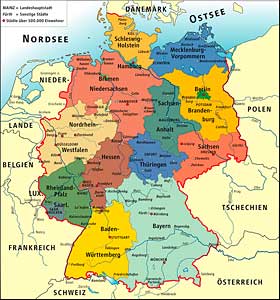| The House of Hanover |
At the time when my great-great-great-grandfather John Henry Doepker (or Johann Henrich Döpker) arrived on the shores of the United States, it was not Germany he was leaving behind. The country he emigrated from was called the Kingdom of Hanover. While German speaking, it was nonetheless a sovereign state, with its own government and eponymously named capital city.
Until 1708, Hanover had been a minor principality within the Holy Roman Empire. In 1708, its lands were combined with most of the Duchy of Brunswick-Lüneburg and became an electorate (essentially, a voting member state) of the Holy Roman Empire. It's rulers belonged to the dynastic lineage of the House of Hanover. In the 1701 Act of Settlement, the wife to Duke Ernest Augustus of the House of Hanover, Duchess Sophia of the Palitinate (who was also to King James I of Great Britain) was declared heir to the throne of Great Britain. When, in 1714, Sophia's son, George Louis became George I, King of Great Britain, Hanover was joined in a "personal union" with Great Britain, essentially coming under the rule of George I. The personal union meant that, while officially ruled from England, Hanover would retain it's own laws, military and feudal structure.
The status quo persisted until 1803 when Hanover was conquered by both Napoleon and the Kingdom of Prussia. In 1806 at the Treaty of Pressburg, 16 states from the Holy Roman Empire, including Hanover, were joined together to form the rather weak Confederation of the Rhine. In 1807, the Treaty of Tilsit declared that Hanover would be joined with part of Prussia to create the Kingdom of Westphalia, ruled by Napoleon's brother Jérôme Bonaparte. Westphalia joined the Confederation of the Rhine soon after. This lasted until 1813 at which time Napoleon had led his disastrous campaign to conquer Russia. When Napoleon was finally defeated in 1813 at the Battle of Leipsig, it spelled the end for both the Confederation of the Rhine and the Kingdom of Westphalia. Rulership over Hanover reverted back to the House of Hanover. |
| The German Confederation, North German Confederation and German Empire |
The Congress of Vienna of 1815 formally decreed Hanover a sovereign state, though still ruled by Austria. It also created the German Confederation, a loosely-knit group of 39 Germanic nation-states of which Hanover was a member. The successive Kings of England continued to rule over Hanover until the reign of Queen Victoria began in 1837. As the laws of Hanover disallowed reign by a female, Victoria's uncle Ernest Augustus I became king of the newly independent Hanover.
The March Revolution in 1848 caused Hanover to temporarily leave the German Confederation, but after they failed, it rejoined in 1850. Hanover remained within the German Confederation until the Austro-Prussian War (or "Seven Weeks War") in 1866. Victory by the Prussians at the battle of Sadowa-Koniggratz meant that Hanoverian states would be ruled from Prussia rather than Austria. What resulted became known as the North German Confederation, ruled by Kaiser Wilhelm I and his appointed Chancellor, Otto von Bismarck. King George V of Hanover, son of Ernest Augustus I, attempted to wrest control back from the influence of the powerful Prussians, but these attempts failed. Hanover would remain in the North German Confederation until 1871 and German Unification.
Minted in Versailles, France in 1871 following victory by the Prussians in the Franco-Prussian War, the First Treaty of Versailles and later the Treaty of Frankfort declared German Unification and led to the creation of the German Empire, largely due to the influence by Bismarck. It joined the states of the Northern German Confederation with those of the Southern German Confederation under Kaiser Wilhelm I and, in 1888, by Frederick III and three months later (following Frederick's death from cancer) by Wilhelm II. The period that followed was characterized by increased industrialization, nationalism and militarization. The German Empire in this form would last until the end of the First World War. |
| World War I |
In 1879, the German Empire had struck an alliance with neighboring Austria-Hungary. Joined later by Italy, the Ottoman Empire and Bulgaria, this group of nations came to form the Central Powers (Italy dropped out in 1915). At the same time, Great Britain, France and Russia became allied, through a number of treaties, in the Triple Entente (they were later simply called "The Allies").
A number of conflicts over colonial possessions with Breat Britain and France, along with Austria-Hungary's conflict with the Russians over the Balkans (Serbia, Bosnia, Kosovo and Herzogovena) caused increased tensions between the Central Powers states and those of the Allies. A spark was all that was needed to set off a major conflict, although the German Imperial War Council of 1912 had already, in essence, made war inevitable. The spark occurred on June 28, 1914, when Archduke Franz Ferdinand of Austria-Hungary was assassinated by Serbian separatists. Soon after, Austria-Hungary declared war on Serbia (which was under the protection of Russia), Russia declared war on Austria-Hungary, Germany declared war on Russia and France, Great Britain declared war on Germany, and Austria-Hungary declared war on Russia.
The First World War would drag on until October 1918, when a revolution began within in the German Empire. Kaiser Wilhelm II subsequently abdicated in November of that year, effectively ending the war. |
| World War II |
The Treaty of Versailles of 1919 at the end of World War I created the German Weimar Republic and effectively ensured that the fledgling
state would be burdened by crippling debt, economic depression, and internal conflict. A number of failed coup attempts
throughout the 1920's kept the German state weak and unstable.
In the elections of 1932, the National Socialist
German Workers Party (the NDSAP or "Nazi" party) gained a plurality of seats in the Reichstag, the reelected
President Hindenburg appointed Adolph Hitler as Chancellor. A combination of the passage of a number of repressive
decrees, the burning of the Reichstag building, new elections in 1933 and the death of Hindenburg in 1934 solidified
Hitler and the Nazi's control of the German state. A subsequent rearming of the German military, in breach of the Treaty
of Versailles, and clearly expansionist policies by the ruling government set it on a course of conflict with the rest
of Europe.
Germany invaded and annexed the Rhineland in 1936. It supported the fascists in the Spanish Civil War in 1937 and annexed Austria and the Sudeten territories of Czechoslovakia in 1938. It finally annexed of the rest of
Czechoslovakia in 1939, but even this was not enough to trigger a war with the rest of Europe. However, in
September 1939 Germany invaded Poland, which had an alliance with Great Britain. The greatest conflict between nations the world has ever seen was under way. By the time of its ultimate
capitulation in May of 1945, millions lay dead and Germany's military, economy, government, infrastructure and social fabric
were in ruins. |
| The Cold War and Reunification |
Following the Second World War, Germany was partitioned between the former allies Great Britain, France, the United States and Russia, with the states of the former Kingdom of Hanover contained within the sector controlled by Great Britain. When, in 1949, Germany was at last given its independence, the eastern segment controlled by the Soviet Union did not reunite with the western segments and instead became the German Democratic Republic (or East Germany), adopting a communist form of government, and effectively becoming a Soviet satellite state.
While the states of West Germany saw significant economic revitalization throughout the 1950's, 60's, 70's and 80's, the East German economy languished under the repressive central control of the communist party and the Soviet Union. By 1989, the populace had had enough and, with the Soviet Union in no position to resist (by then its own economy was in shambles), mass demonstrations in East German cities forced President Erich Honneker to resign in November. Soon after, the borders between East and West Germany were opened and the process of reunification had begun. On October 3, 1990, Germany was at last reunified.
What was once the Kingdom of Hanover is now the German state of Niedersachsen (or Lower Saxony), with its capital in the city of Hanover. The boundaries of Lower Saxony are nearly identical to those of the former Kingdom of Hanover. |
|
|
| Historical Maps |
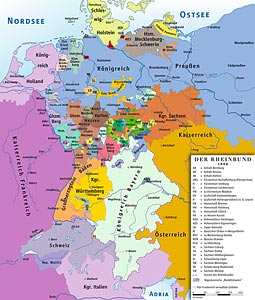
Confederation of the Rhine, 1808
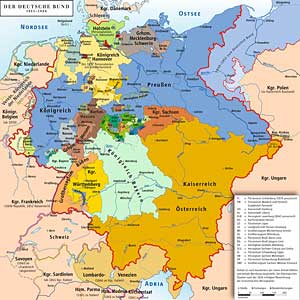 German Confederation, 1820-1866 German Confederation, 1820-1866

Kingdom of Hanover, 1820-1866
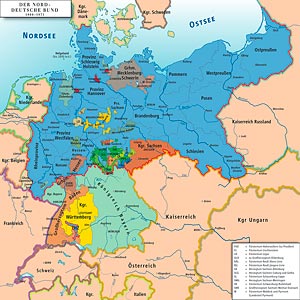 German Empire (in blue), 1871-1918 German Empire (in blue), 1871-1918 |
| Insignia |
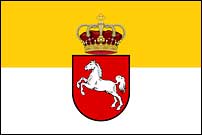
Flag of the Kingdom of Hanover
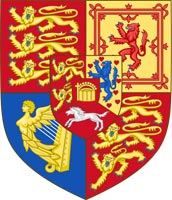
Coat of Arms, Kingdom of Hanover |
|
